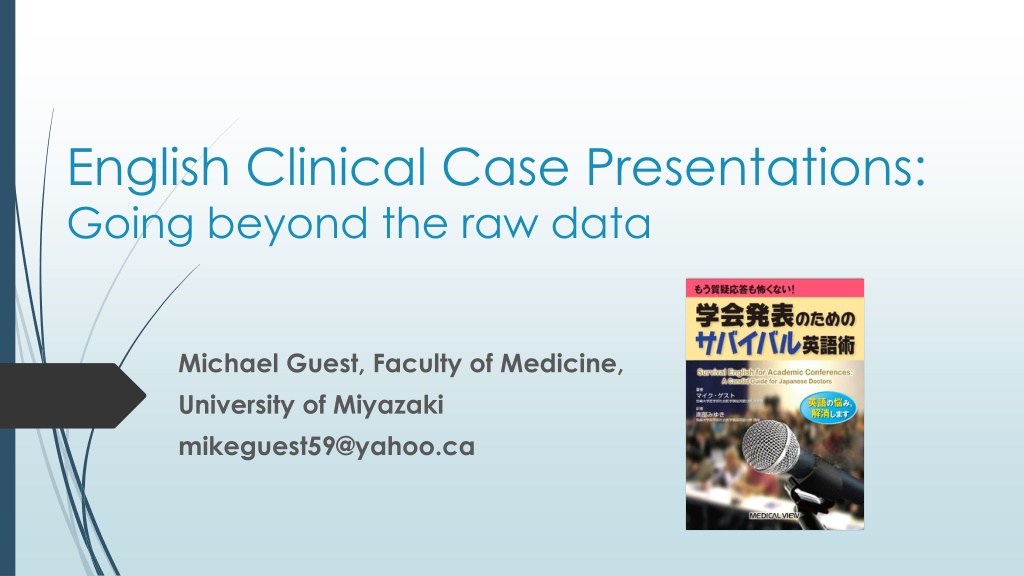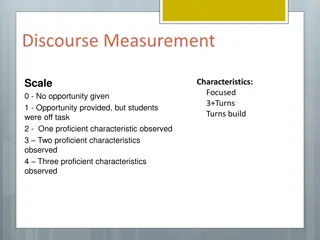Understanding Clinical Case Presentations in Medical Discourse
Clinical case presentations play a crucial role in medical education and practice. They are key in teaching English for Medical Purposes, providing practical applicability to learners. Key factors such as pertinence, speed, accuracy, completeness, and use of standardized language forms are essential in case presentations. Standard categories and steps are outlined to guide the teaching process, emphasizing the importance of authentic case profiles and student-generated responses.
- Clinical Case Presentations
- Medical Discourse
- English for Medical Purposes
- Teaching Methods
- Medical Education
Download Presentation

Please find below an Image/Link to download the presentation.
The content on the website is provided AS IS for your information and personal use only. It may not be sold, licensed, or shared on other websites without obtaining consent from the author. Download presentation by click this link. If you encounter any issues during the download, it is possible that the publisher has removed the file from their server.
E N D
Presentation Transcript
English Clinical Case Presentations: Going beyond the raw data Michael Guest, Faculty of Medicine, University of Miyazaki mikeguest59@yahoo.ca
Clinical Case Presentation Scenarios: Where do they occur? As part of a conference presentation As Doctor-Doctor or AHP-AHP workplace discourse As an inter-departmental discussion/report/meeting As training for OSCE/USMLE exams
Clinical case presentations are 1. primary examples of medical discourse (and, therefore, suited to teaching English for Medical Purposes EMP) 2. an established, prototypical speech event within the medical discourse community 3. forms that have a positive washback effect on the learner s first language and workplace 4. Forms that have immediate practical applicability and value That s why they should be highlighted for and practiced among even the youngest medical students
Key Factor #1: Pertinence What does the doctor/AHP need or want to know? What are the case priorities? What was/is necessary for clinical decision-making? Key Factor #2: Speed Which abbreviations/ellipsis can or should be used in speech? What data can be safely omitted? Key Factor #3: Accuracy Key Factor #4: Completeness Key Factor #5: Use of standardized language forms
Standard categories included in a case presentation: ID (basic patient data) Chief Complaint HPI (OPQRST + associated symptoms, risk factors/complications) PMH (inc. surgeries, hospitalizations, underlying conditions, injuries) Current medications/allergies/treatments Family History Social History Physical Examinations (inc. vital signs, review of systems, possibly Ht/Wt/BMI) Investigations (lab/imaging/biopsy etc.) Summary Differential/provisional diagnoses Assessment and treatment/management plan Follow-up Treatment successes/failures/adherence
Steps to teaching clinical case presentations 1.Authentic case profiles can initially be used by the teacher to illustrate the process 2.Lists of typical response items can be generated by teachers, clinicians, and students 3.Students can then gradually develop their own invented clinical case profiles (later evaluated)
Sample case data: ID/CC/HPI 1. ID: Name, age, sex, occupation The patient was a (name), a (age)(sex)(occupation) 2. Chief complaint and duration who presented with (CC) of x duration 3. Explain HPI following the OPQRST method: Onset, Provoking factors, Quality, Region/Radiation, Severity, Time (frequency, length per episode, occurrence patterns) Explain these in order of pertinence, plus any associated symptoms, complications, and/or risk factors: She also complained of/mentioned X. Complications/risk factors include X.
Past Medical History (PMH): Including chronic/underlying conditions, hospitalizations, surgeries, major injuries/traumas, ongoing treatments Her PMH is significant for At age __ she was treated/hospitalized for __ was/has been diagnosed with __ She has X/is suffering from chronic __ Current medications/allergies/treatments She is currently taking/being prescribed _/being treated for __ She is allergic to _
Family history and Social history: Congenital diseases/conditions, alcohol, smoking, drugs, sex, dietary, exercise, sleeping, and working habits Her FH/SH is significant for Y. Her FH/SH is insignificant/unremarkable. Her (family member) died of __ at age __ /was diagnosed with __ Her (family member) suffers from/has been diagnosed with __ Sleeping/working/dietary/exercise habits Sex: Sexually active? Partner(s)? Practices safe sex/promiscuous? Alcohol/smoking habits (Illicit/recreational) Drugs: Has (no/a) habit/history of
Physical Examination & Review of Systems Her vital signs were ____ On examination, her __ was ___ /we found __ Her (systems check or PE result) is significant for ___ The __ was normal/ ____ was within normal range Nothing abnormal (was) detected (NAD) The ___ was palpable HT? WT? BMI? (if significant)
Labs/imaging/investigations (Workup) We performed a (examination/operation type) to/for (purpose) The ___ showed/revealed (an elevated/reduced __ level/count) The ___ is/was significant for (result) The ___ is/was notable for (result) The ___ was within normal limits The ____ results were negative/positive/indicated ______. In particular you should note__ (*for significant results)
Summary sample In summary, this is (ID) who presents with (CC/duration) with (pertinent symptoms, complications or risk factors + any significant current treatments/medications/underlying conditions) PMH/FH/SH is significant for ___. (Vitals/Physical Exams) were (significant results) (Labs/imaging investigations): showed/indicated (significant results) were positive/negative
Diagnoses Initial/Provisional diagnosis (PD) o __ is suspected/Our PD is __ due to (factors/symptoms/results), with a __% possibility of certainty. Differential diagnosis (DD) o (Results/symptoms) suggest __. So, our DD is ___ (due to/a result of/because of ___ .) Other considered diagnoses and negative diagnoses o We also consider(ed)__ but we ruled out ___ because of/due to ___. Conclusion o This is a patient with _____/The patient has ____.
Assessment & plan (including risks), treatment, and follow-up o We will perform an __/assess the patient s ___/ The patient will undergo ___ o We are treating the patient with ___/The patient will receive ___ (depending upon ___) o The plan is to do __ (but there is a slight/high risk of __.) o ___ is/will be important in follow-up o The patient has been/will be treated by Dr. ___. The next consultation is ___.
Key or notable time-related phrases Until __ days ago/for (duration)/since (onset) Sudden vs. gradual (onset) Over the past __ days __ days after the initial visit __ days prior to admission On admission, In the following hours/on the following day During the follow-up sessions She has vs. was vs. is (do)ing
Are there any items that should added, adjusted, deleted or fixed? Evaluation: 1. Students, in pairs, give their invented case presentation to another student, who confirms and documents the data. This process is then carried out in reverse. The teacher monitors and collects the student data at the end (10- 12 minutes in total) 2. Teacher reports a clinical case and students are required to take down the data accurately (and, perhaps, confirm in speech) Evaluation rubric: Speed Pertinence of data Accuracy/Thoroughness Medical consistency (research may be necessary) Use of accepted clinical language forms
THANK YOU! mikeguest59@yahoo.ca michael@med.miyazaki-u.ac.jp























